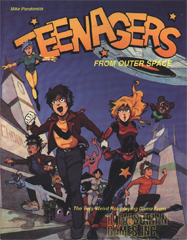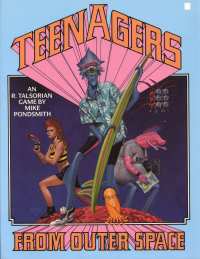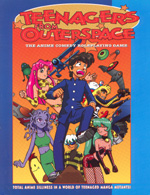


A little out of sequence, but I’ve not done one of these in ages and this particular game has some relation to the bulk of what I’ve spent 2009 writing about on here.
You see, in everything but name, Teenagers From Outer Space is “Urusei Yatsura: The Role-playing Game”. I first picked it up around the time I was getting into anime, and I think I knew where its influences lay back then. Not that you’d have known it from the 2nd edition I found in a second hand book bin in Hull. That was printed in 1988 and had a cover that was more reminiscent of Galaxy High (coincidentally a show Japanese studio Telecom had worked on). I now see that the very first edition had had a more obviously anime inspired cover, so maybe it’s failure to set the world of fire led to this more traditional approach (interior art edges perhaps closer to Archie Comics house style than US Takahashi-clone).
But the actual contents were clearly inspired by Urusei Yatsura. The rules allowed you to play either humans or varying degrees of alien. Aliens had super powers such as flight, shooting electricity (Lum!), breathing fire (Ten!) and the like. Humans also had more powers like being incredibly endurable (Ataru), filthy rich (Mendou) or super strength (Shinobu).
Where the influence really shown through though was in the 20 mini-adventures, some of which you can see direct parallels with specific UY episodes, and in the some of the “goodies” (equipment) which included duplicating guns, mind swapping earmuffs and boy/girl guns.
In 1997, R Talsorian Games didn’t hide their anime influences under a bushel, and had released the Bubblegum Crisis, DBZ and Votoms games at this point. So they put Mekton Zeta and a re-release of TFOS under their ANimechaniX banner (inexplicable capitlisation RTG’s own).
This time the game had a firmly anime/manga aesthetic, drafting in US furry artists (that US furry/anime fandom connection raising it’s head again!) & Stratelibri (Italian gaming company) bods for the art (as well as a few left over bits of Scott Ruggles art from the 2nd edition). And it expressly mentioned anime in the actual text of the rulebook. Combined with extra material dealing with specifically Japanese bits and pieces, it finally felt like the product it always should have been.
So how does it play? Very well, if you like rules light, fast, silly games. Same basic mechanics as the bulk of RTG’s games (stat+skill+die roll vs. difficulty), but stripped down for speed. And unlike Cybergeneration (which I’ll get to later) I actually got my monies worth out of this game. The play style it lends itself to definitely fits more into my improv-tinged gaming ethos. The third edition may even be in my top ten favourite RPGs. We’ll see, if I ever get round to finishing this series of posts!
Possible bonus US RPG Scene/Anime Scene collision later tonight!